Perpetual Pavement Practices Convert Concrete Interstates in Illinois
BY AsphaltPro Staff
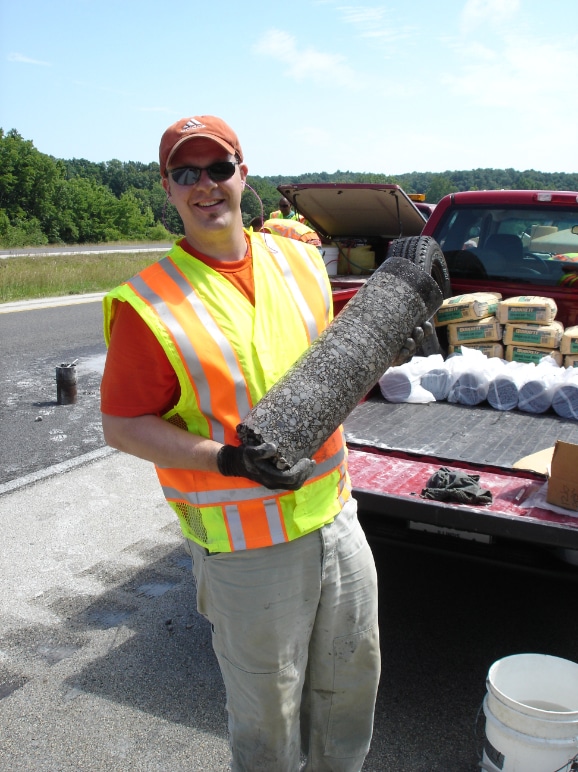
Earlier this year, the Asphalt Pavement Alliance (APA) honored the first six recipients of APA’s newest Perpetual Pavement Award (PPA) category, PPA: By Conversion. Among the inaugural recipients of the PPA: By Conversion recognition was the Illinois Department of Transportation (IDOT) for a 9.5-mile HMA/rubblization project on Interstate 70 from milepost 136 to 146 in Clark County.
The four-lane award-winning section of I-70 was constructed by Howell Paving, Champaign Asphalt (now part of Open Road Paving Company LLC) and Howell Asphalt and opened to traffic in 2003.
“The project demonstrated to the Department that the perpetual pavement concept works and led to rubblization being adopted as a routine option for the Department,” said Kevin Burke, executive vice president of the Illinois Asphalt Pavement Association.
According to APA, IDOT has been an early adopter of the rubblization process. “The by-conversion was a first for Illinois and opened the door for this type of design,” said APA National Director Amy Miller.

On May 10, 2022, APA National Director Amy Miller, P.E., presented representatives from IDOT with their PPA: ByConversion for their I-70 Extended Life HMA/Rubblization (MP 136-146) project in Clark County. Members of Howell Paving, Open Road Paving, LLC, and Howell Asphalt were also recognized for their work on this award-winning Perpetual Pavement asphalt.
IDOT ultimately decided to rubblize the existing concrete to provide a structural base and a drainage layer before being overlaid with a total of 17.5 inches of extended life hot mix asphalt (HMA) for a design life of 30 years.
“A significant reason [this design was selected] was that I-70 is a very busy route, especially with truck traffic,” said John Senger, engineer of pavement technology for IDOT. Today this section of I-70 sees roughly 25,400 vehicles per day with 52% truck traffic. “Before this project, we had never placed full depth HMA on such a high-volume truck route before, so it was kind of an experiment.”
According to Marshall Thompson, professor emeritus at University of Illinois’ Grainger College of Engineering, Illinois was “basically a concrete pavement state” at the outset of the interstate highway system. Thompson was an undergraduate student when the American Association of State Highway Officials (AASHO) Road Test in Ottawa, Illinois, was concluded in 1960. Throughout his six decade career, Thompson has seen Illinois change its approach.
“It wasn’t until 1989 that we began building full depth asphalt pavements,” Thompson said. “One of the issues IDOT was facing around the time the I-70 project was how to rehabilitate the original interstate concrete system.”
IDOT decided to perform a comparison across adjacent sections of I-70, including a control section with a standard mill and fill with 5 inch HMA overlay and a section with 12 inches of unbonded concrete overlay (UBOL) after milling to profile.
When tests were performed in 2018, the rubblized/HMA section had rutting of 0.11 inches, CRS of 8.0, and an IRI of 48. A CRS of 8.0 is not only well above the full-depth HMA model of around 5.6 and the CRCP model of around 6.9, but it is also better than the 7.7 achieved on the adjacent CRCP UBOL project. The IRI of 48 on the HMA section was also better than the UBOL section with an IRI of 75.
“The concrete sections out there have not performed as well as the asphalt overlays,” Thompson said. “I don’t think anyone would dispute that.”
“Overall, we’ve had excellent performance of HMA overlays on rubblized concrete in Illinois,” Thompson said. “And it’s very cost effective. When we get into extensive patching of our old concrete pavements, the costs are out of sight.”
To qualify for a PPA: By Conversion, the pavement must be an asphalt road constructed over an existing road that meets Perpetual Pavement criteria, demonstrate the quality and excellence APA expects from long-life asphalt pavements, and design criteria must be reviewed and approved by the National Center for Asphalt Technology.
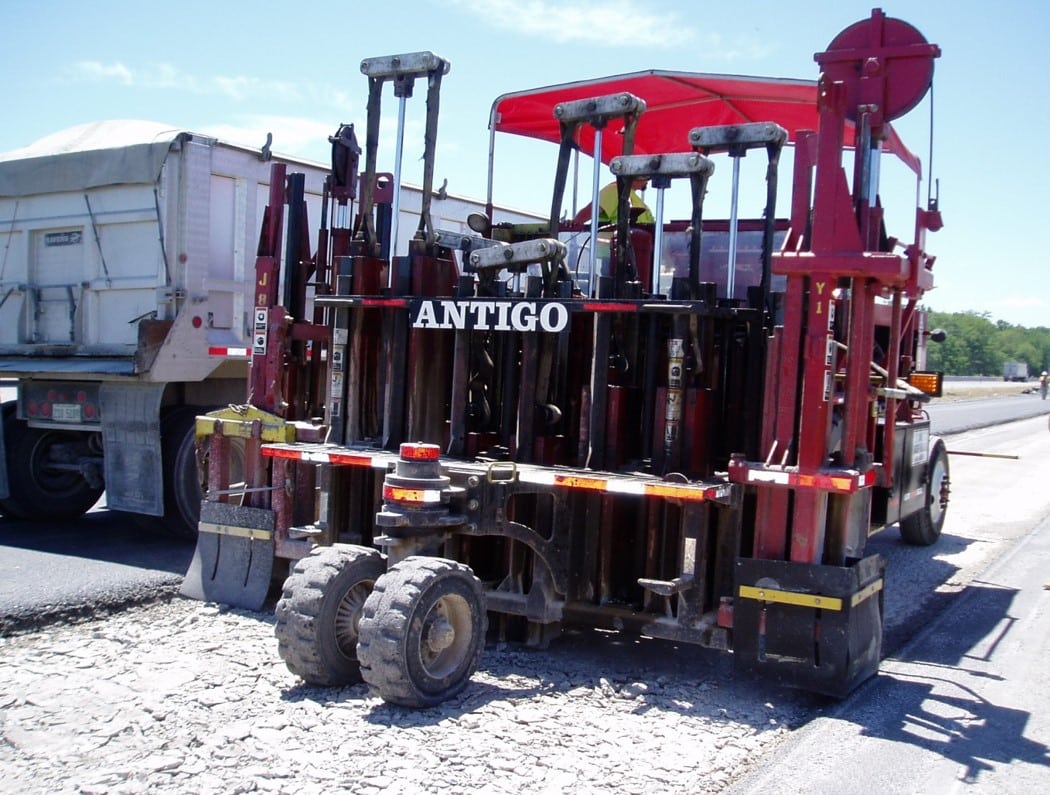
After the contractor milled to remove the overlays, they broke the concrete pavement with an Antigo multi-head breaker then ran it over with a Z-grid roller.
Rise of Rubblization
IDOT’s first rubblization/HMA overlay project was performed in 1996 on I-57 just south of Effingham, Thompson said. “By the time we got to the I-70 project, we had done quite a bit of rubblization from 1996 and 2003,” he said.
The original surface of that portion of I-70 was 8-inch CRCP constructed in 1971. Since then, the pavement received two asphalt overlays. After the contractor milled to remove the overlays, they broke the concrete pavement with an Antigo multi-head breaker then ran it over with a Z-grid roller.
“We’ve had excellent success with rubblized concrete, particularly on interstates,” Thompson said. “We’ve done many miles of rubblized concrete on our interstates since and after looking at the performance of those sections, we’ve had no fatigue problems. Most of the distress has been environmental, so we can do a mill and fill and get the pavement back to 100%.”
“It was the success of the I-70 project that propelled the use of rubblization/HMA overlays on our interstates,” Senger said. “Now, we’ve done quite a few—especially on interstates where it’s very important to maintain traffic and not have large detours. Plus it allows us to turn the existing material into a very stable base while eliminating the durability/cracking problems with older concrete pavement. Once it’s rubblized, you can place a full depth HMA pavement on top of it and get a very successful life out of it.”
Overlay with HMA
However, rubblization is only one part of the equation. The HMA overlay is another. In order for a pavement to be considered an extended life HMA, IDOT requires one or more of the following elements: SMA surface; polymer used in all lifts; 1% hydrated lime (dry) anti-strip in all lifts; polymer tack coat between lifts; extra tack coat on longitudinal joints, which has been replaced with a VRAM since the I-70 project’s construction; material transfer vehicle use on all lifts; and/or no rich bottom layer base.
For the award-winning I-70 project, IDOT opted for a polymer in all lifts and a design of five lifts: two 5-inch lifts of N90 19.0 binder course with PG70-22 (183,301 tons total), a 3-inch lift and a 2.5-inch lift with N105 19.0 binder course with PG76-28 (93,141 tons), capped with a 2-inch lift of N80 steel slag SMA 12.5 surface course with PG76-28 and a layer coefficient of 0.4 (42,239 tons).
“This project has held up so well specifically because it’s 17.5 inches thick and there’s polymer through all the lifts,” Senger said. “We’ve also seen really good performance from SMA asphalt. The higher binder content really helps with oxidation and aging. Last time I drove this route, the surface was still black like the day it was paved.”
According to Thompson, IDOT had been investigating the idea of making HMA pavements last longer under the concept of long-life pavements since the 1990s. By the time this portion of I-70 was paved, that had evolved into the concept of perpetual pavements.
“Early on, we used a typical fatigue-driven approach where the more traffic you have, the thicker pavement you get,” Thompson said, adding that IDOT has utilized mechanistic-empirical design for full-depth asphalt pavements since 1989. “The traffic numbers for I-70 were very high, so that section is fairly significant in terms of thickness.”
“This project provided us with confirming data that thicker pavements last a longer time,” Thompson said. However, Thompson said it was the superior performance of this section of I-70 that indicated IDOT’s fatigue algorithm approach was too conservative for high-traffic volume pavements. Ultimately, the project helped shape IDOT’s approach to the perpetual pavement concept while also reducing thickness.
“We learned a lot from that project,” Thompson said. “We are still conservative, but not as conservative as we were before.”
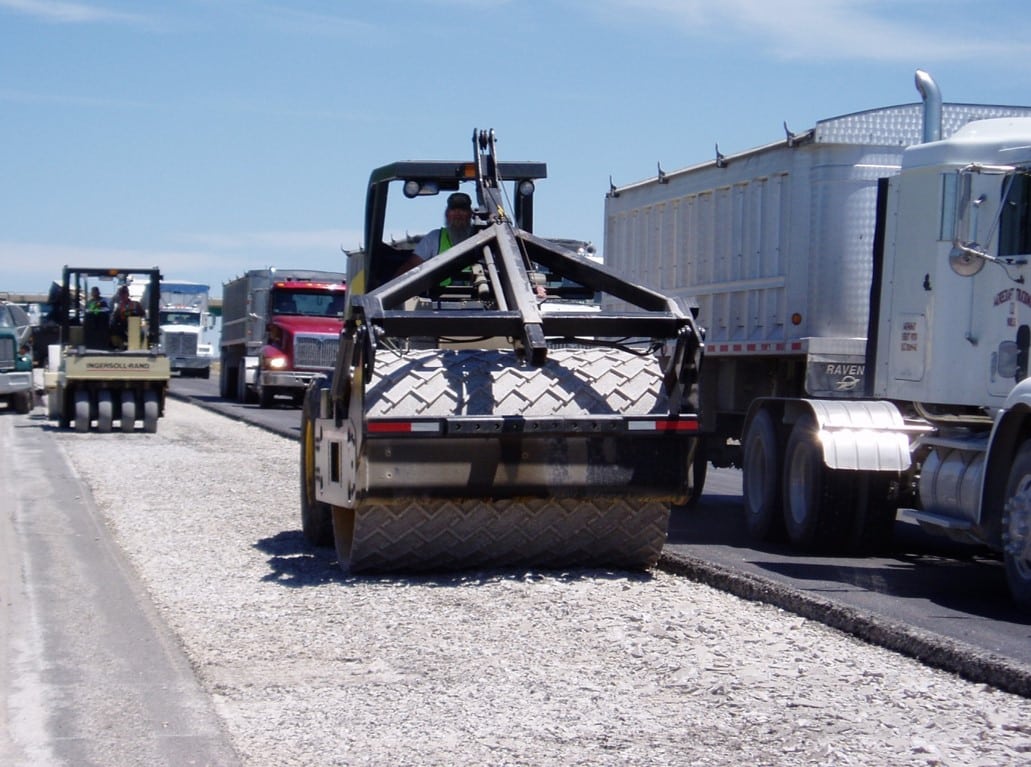
After the contractor milled to remove the overlays, they broke the concrete pavement with an Antigo multi-head breaker then ran it over with a Z-grid roller.
Thin to Win
According to Senger, the I-70 project was designed before IDOT performed pavement life cycle cost analyses for all its pavements. Now, IDOT must perform this analysis on any new pavement more than 4,750 square yards. “The option with lower life cycle cost will win the bid as long as it’s more than 10% below the other option,” he said.
“Thickness plays a huge role in what that costs over the pavement’s lifetime,” Senger said. “In order to keep HMA as competitive as possible, it’s best for us to opt for thinner HMA pavements without sacrificing performance.”
“In 2003, we were still using our initial fatigue algorithm, which was very conservative and contributed to the thickness of that pavement,” Thompson said. “Sam Carpenter on our U of I staff did a lot of fatigue work with various Illinois mixes and his results suggested these overlays were performing better than our algorithm predicted.”
In 2010, IDOT made adjustments to its mechanistic-empirical pavement design to include a fatigue endurance limit (limiting strain criterion) of 70 microstrain for the bottom binder layer, which reduced the overall thickness of HMA. “That’s led us to a 16.5-inch upper limit for full-depth HMA,” Senger said. For HMA overlays over rubblized concrete pavements, Thompson said IDOT’s upper limit is 11.75 inches. If the I-70 project occurred today, the overlay would be 11.25 inches thick.
“Based on the data we’ve developed over the years, we’ve got HMA overlays on rubblized concrete [interstates] as thin as 8 inches,” Thompson said. “We even have an experimental section of I-57 near Effingham with a 6-inch overlay that’s been performing quite well.”
“Typically everyone winds up being on the conservative side with perpetual pavement designs because you’d rather the pavement last longer than not last long enough,” Thompson said. “But within the perpetual pavement concept, we’re reducing the thickness and they’re still doing quite well.”
“Essentially, what we’re trying to do is to balance being conservative with keeping HMA competitive so we can get the best possible pavements as possible,” Senger added.
Perpetual Pavement Performs for “Peanut Capital of the World”
Decades of Performance
Nearly 20 years after the HMA overlay was placed on I-70, it is still performing quite well.
“We don’t see too many HMA pavements last this long with such little maintenance,” Senger said. “It’s probably getting to the point where the district needs to seal this up to stop further oxidation and water intrusion, but structurally this is performing really well and we think it will for the foreseeable future.”
The most prevalent issue on the project is some centerline distress, Senger said. “That happens with all the older pavements,” he added. “However, we have some new processes in place to hopefully take care of that.”
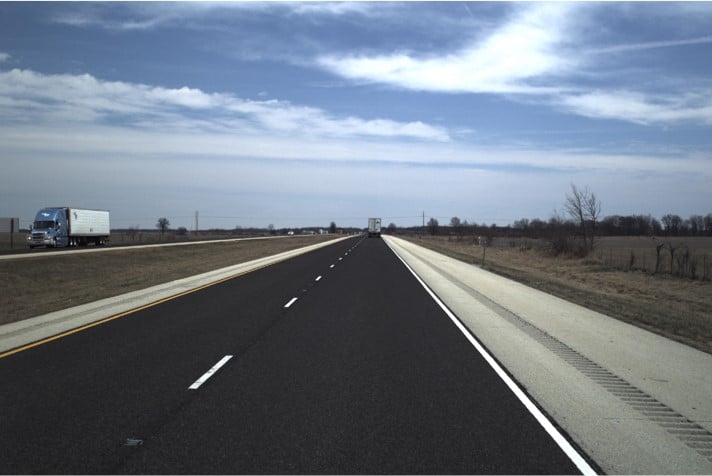
When tests were performed in 2018, the rubblized/HMA section had rutting of 0.11 inches, CRS of 8.0, and an IRI of 48.
Since the I-70 project was completed in 2003, IDOT has made great strides in reducing centerline distress through the implementation of longitudinal joint sealant (LJS). “We did five experimental projects with LJS and fully implemented that in 2016 so all our new asphalt pavements and overlays use LJS,” Senger said. “Now that we can get a joint to last 15 to 20 years with LJS, we can get that surface to last much longer before we need to do major rehabilitation.” He expects in the next five or so years that the award-winning portion of I-70 will require a mill and fill, and when that’s done, it’ll be done with LJS.
That’s the way IDOT is moving forward with perpetual pavements. “Over time, we’re identifying and tackling a lot of the weaknesses of our HMA designs,” Senger said. “Our mechanistic designs these days are often getting us into the perpetual pavement design timeframe.”
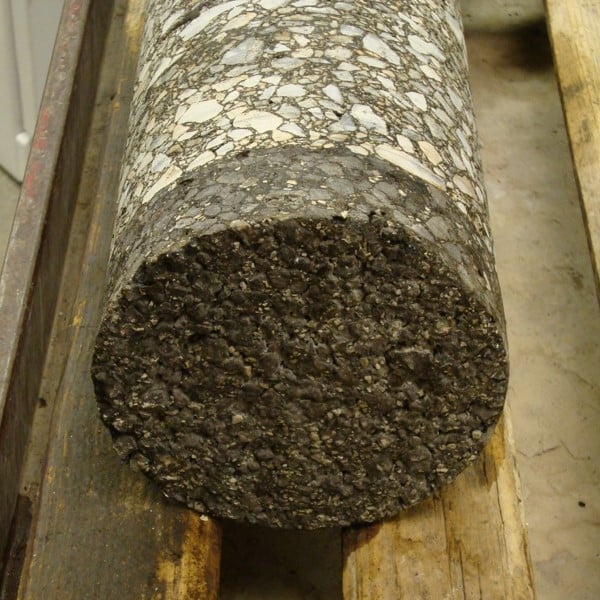
The job required 183,301 tons of N90 19.0 binder course with PG70-22, 93,141 tons of N105 19.0 binder course with PG76-28 and 42,239 tons of of N80 steel slag SMA 12.5 surface course with PG76-28.
Performance, Guaranteed
Not only was the I-70 project a perpetual pavement, but it was also the first warranty project IDOT let. Mandated by Illinois FIRST legislation of 1999, IDOT implemented a five-year performance warranty on the project. “The asphalt industry advocated for a 20-year warranty because the industry was confident in the future performance,” Burke said.
The legislation also required extended life designs, which aim to achieve a 30-year life cycle without requiring major rehabilitation or patching other than surface replacement at some frequency. Ultimately, there were no warranty repairs on the pavement, though some were required on the bridge decks.
“The warranty probably played a role in the contractor’s performance on it, but we can attribute the success of this project to a lot of different areas beyond the warranty,” Senger said. For example, the location in the southern part of the state where there’s less freeze-thaw and fewer snow plows, the polymer in every lift of asphalt, the use of SMA for the top lift and the thickness in general.
“We didn’t really hold anything back on this project,” Senger said. “We gave it every chance we could to succeed, and it’s done that and more.”
